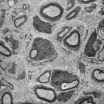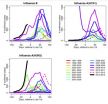The tales teeth tell
Tooth development and weaning in chimpanzees not as closely related as once thought, researchers say
2013-01-29
(Press-News.org) For more than two decades, scientists have relied on studies that linked juvenile primate tooth development with their weaning as a rough proxy for understanding similar developmental landmarks in the evolution of early humans. New research from Harvard, however, is challenging those conclusions by showing that tooth development and weaning aren't as closely related as previously thought.
Using a first-of-its-kind method, a team of researchers led by professors Tanya Smith and Richard Wrangham and Postdoctoral Fellow Zarin Machanda of Harvard's Department of Human Evolutionary Biology used high-resolution digital photographs of chimps in the wild to show that after the eruption of their first molar tooth, many juvenile chimps continue to nurse as much, if not more, than they had in the past. Their study is described in a January 28 paper in the Proceedings of the National Academy of Sciences.
"When these earlier studies were published about 20 years ago, they found a very tight relationship between the eruption of the first molar and certain developmental milestones, particularly weaning," Smith explained. "A number of researchers have tried to extrapolate that relationship to the human fossil record, but it now appears that our closest living relative doesn't fit that pattern. That suggests we should be more cautious if we want to infer what juvenile hominins were like."
Getting an inside view of chimpanzee childhood, however, is no easy task.
Most prior studies of tooth development in juvenile chimps relied on two methods of collecting data – observing captive animals or studying skeletal remains of wild primates. Both, however, also came with challenges for researchers.
Studies have shown that captive chimps grow dramatically faster – often reaching adult size by age 10 or 11, compared to 13 to 15 for wild chimps. That early development means the milestones researchers rely on as proxies for understanding early human species likely occur earlier than they normally would. Researchers studying skeletal remains of wild primates face a similar challenge. To properly understand those developmental landmarks, remains must be properly identified and aged, a notoriously difficult process for primates in dense tropical forests.
To solve those problems, Smith, Wrangham and Machanda developed a unique method for studying juvenile chimps in the wild. Researchers studying the Kanyawara chimpanzee community in Kibale National Park in Uganda teamed up with wildlife photographers who snapped photos of juvenile chimp's teeth whenever they opened their mouths. The detailed photos, some of which captured the same individuals over months, allowed researchers to track precisely when molars erupted, and to correlate that information with chimp's behavior more closely than ever before.
What the images revealed, Smith and Machanda said, came as a surprise.
Where earlier studies suggested that juvenile primates were weaned shortly after their first molar erupts, their study showed that, in addition to eating more solid food, chimps continued to "suckle as much, if not more, than they had before," Smith said. "They were showing adult-like feeding patterns while continuing to suckle, which was unexpected."
While questions of why juvenile chimps continue to nurse – in some cases for months – have yet to be answered, Machanda said those questions will likely be the subject of future studies.
"We're now working on a project that's focused on body size and growth, but we're also planning future studies that will look at their energetic condition so we can understand what they're trying to get from the mother by continuing to nurse," she said. "What's interesting, however, is that there can be conflict surrounding this where the juveniles are trying to get as much as possible from the mother and the mother is actually covering up her nipples and moving around. Sometimes they'll even throw these temper tantrums that look exactly like human babies."
"I think there are two bottom lines here," Smith said. "One, I think, is a cautionary tale. The findings in this paper are going to challenge us to find other proxies for weaning and the spacing between offspring, but the other aspect that's exciting is that we have some suggestion that we should start looking at how feeding behaviors develop in the wild.
"No one has looked at how infants become more adult-like, both in their food choice and in the time they spend feeding," she continued. "This actually appears to correlate fairly well with dental development, so, while this is a preliminary finding, we may have a new anatomical proxy for when juvenile primates begin eating like adults."
INFORMATION: END
ELSE PRESS RELEASES FROM THIS DATE:
2013-01-29
This press release is available in German.
Unlike the brain and spinal cord, the peripheral nervous system has an astonishing capacity for regeneration following injury. Researchers at the Max Planck Institute of Experimental Medicine in Göttingen have discovered that, following nerve damage, peripheral glial cells produce the growth factor neuregulin1, which makes an important contribution to the regeneration of damaged nerves.
From their cell bodies to their terminals in muscle or skin, neuronal extensions or axons in the peripheral nervous system are surrounded ...
2013-01-29
Alexandria, VA – Would you drink water from a toilet? What if that water, once treated, was cleaner than what comes out of the faucet? Although the imagery isn't appealing, as climate change and population growth strain freshwater resources, such strategies are becoming more common around the world — and in the United States.
Over the last several decades, local and regional water shortages have become increasingly common. These shortages have led to increased friction over water resources. Technologies are currently being developed to help make wastewater recycling ...
2013-01-29
Using an exotic form of silicon could substantially improve the efficiency of solar cells, according to computer simulations by researchers at the University of California, Davis, and in Hungary. The work was published Jan. 25 in the journal Physical Review Letters.
Solar cells are based on the photoelectric effect: a photon, or particle of light, hits a silicon crystal and generates a negatively charged electron and a positively charged hole. Collecting those electron-hole pairs generates electric current.
Conventional solar cells generate one electron-hole pair ...
2013-01-29
SEATTLE – Regular consumption of deep-fried foods such as French fries, fried chicken and doughnuts is associated with an increased risk of prostate cancer, and the effect appears to be slightly stronger with regard to more aggressive forms of the disease, according to a study by investigators at Fred Hutchinson Cancer Research Center.
Corresponding author Janet L. Stanford, Ph.D., and colleagues Marni Stott-Miller, Ph.D., a postdoctoral research fellow and Marian Neuhouser, Ph.D., all of the Hutchinson Center's Public Health Sciences Division, have published their findings ...
2013-01-29
The American public can expect to add earlier and more severe flu seasons to the fallout from climate change, according to a research study published online Jan. 28 in PLOS Currents: Influenza.
A team of scientists led by Sherry Towers, research professor in the Mathematical, Computational and Modeling Sciences Center at Arizona State University, studied waves of influenza and climate patterns in the U.S. from the 1997-1998 season to the present.
The team's analysis, which used Centers for Disease Control data, indicates a pattern for both A and B strains: warm winters ...
2013-01-29
As the number of women in the military increases, so does the need for improved gynecologic care. Military women may be more likely to engage in high-risk sexual practices, be less likely to consistently use barrier contraception, and, therefore, more likely to contract sexually transmitted infections (STIs), according to research recently released by a physician at Women & Infants Hospital of Rhode Island.
Vinita Goyal, MD, MPH, followed up earlier research into the rates of contraception use and unintended pregnancy by today's military women and veterans with her latest ...
2013-01-29
According to a new technical report, the effects of climate change will continue to threaten the health and vitality of U.S. coastal communities' social, economic and natural systems.
The report, Coastal Impacts, Adaptation, and Vulnerabilities: a technical input to the 2013 National Climate Assessment, authored by leading scientists and experts, emphasizes the need for increased coordination and planning to ensure U.S. coastal communities are resilient against the effects of climate change.
The recently released report examines and describes climate change impacts ...
2013-01-29
New research from the University of British Columbia is shedding light on why enticing pictures of food affect us less when we're full.
"We've known that insulin plays a role in telling us we're satiated after eating, but the mechanism by which this happens is unclear," says Stephanie Borgland, an assistant professor in UBC's Dept. of Anesthesiology, Pharmacology and Therapeutics and the study's senior author.
In the new study published online this week in Nature Neuroscience, Borgland and colleagues found that insulin – prompted by a sweetened, high-fat meal – affects ...
2013-01-29
How does being in a position of power at work, with friends, or in a romantic relationship influence well-being? While we might like to believe the stereotype that power leads to unhappiness or loneliness, new research indicates that this stereotype is largely untrue: Being in a position of power may actually make people happier.
Drawing on personality and power research, Yona Kifer of Tel Aviv University in Israel and colleagues hypothesized that holding a position of authority might enhance subjective well-being through an increased feeling of authenticity. The researchers ...
2013-01-29
Montréal, January 28, 2013 – IRCM researchers, led by endocrinologist Dr. Rémi Rabasa-Lhoret, were the first to conduct a trial comparing a dual-hormone artificial pancreas with conventional diabetes treatment using an insulin pump and showed improved glucose levels and lower risks of hypoglycemia. Their results, published today in the Canadian Medical Association Journal (CMAJ), can have a great impact on the treatment of type 1 diabetes by accelerating the development of the external artificial pancreas.
The artificial pancreas is an automated system that simulates ...
LAST 30 PRESS RELEASES:
[Press-News.org] The tales teeth tell
Tooth development and weaning in chimpanzees not as closely related as once thought, researchers say


